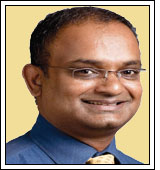
Smart Grid is grid modernization and effective energy management from generation to consumption. The EPRI definition of Smart Grid states: A Smart Grid is one that incorporates information and communications technology into every aspect of electricity generation, delivery (transmission & distribution) and consumption in order to minimize environmental impact, improve reliability, service, efficiency, and reduce costs. To the EPRI definition, we would also add asset modernization as an important element of Smart Grid.
Let us look at the different aspects of Smart Grid from generation to consumption.
Generation: The generation mix has undergone a lot of change in the recent years with increased focus on renewable energy additions. The ability to use renewable energy is limited by the fact that renewable energy sources are intermittent. Intermittency brings the quality and reliability of power under question if more than 20 per cent of generation is dependent on renewable sources like Wind and Solar. With increased advancements in controls & power electronics technologies it has been possible to ensure that we continue to maintain the grid stability under such conditions through effective power factor control and intelligent resource deployment.
Transmission: Transmission occurs at high-voltages (and lower currents) so as to minimize the I2R losses. In addition to the I2R losses, reactive losses in transmission can be significant. Another issue is that of grid congestion with increased generation capacity and demand but with a grid that is behind times. Smart Grid encompasses existing technologies to mitigate losses such as intelligent deployment of capacitor banks to offset reactive losses and new opportunities through the visualization and prediction of grid state to handle grid congestion issues. The technologies developed monitor the transmission network continuously through phasor measurement units coupled with the SCADA (Supervisory Control & Data Acquisition) System and build intelligence to the grid management by helping to identify power flows, load balancing and predict any major interruptions in the network.
Distribution: Coming to distribution the challenges are more around technical losses, managing congestion, outage management and power theft. In a round table on Smart Grid organized by the Digital Energy Solutions Consortium, representatives from the Indian Ministry of Power highlighted detection of theft as a chief area of focus. Smart Grid for distribution requires asset modernization (transformers, switches, and breakers) and will provide tools for optimal asset deployment. In addition effective visualization and better measurement of power flow can identify and isolate theft locations. Some of the technologies deployed to enable manage outages better is an automated outage management system which helps in locating the co-ordinates of outage incident and help in mobilizing the crew in the shortest possible time. This is possible because of the underlying geographical information of the network available with the SW with all minute details of the network components. This is another example of improving the productivity and availability our electrical grid to the end customers through information and communication technology. Our recent implementation in one of the distribution companies in India will help the customer to manage his network better during such outages.
Consumption: In terms of consumption an important aspect of Smart Grid is the ability to support distributed power generation where consumers are able to feed back into the grid. Also, with open access and power trading gaining more importance and attention, the consumers can deploy their appliances during off-peak tariff hours using smart meters with integrated appliance programming, control and two way communications. The future promises an increase in EVs (Electric Vehicle) and for this to be effective and not disrupt grid stability, the grid needs to turn smart and deliver power to the vehicle while optimizing availability and other demands. Smart metering and Smart appliances will bring the smart grid to the consumer. There are technologies today which have ability to communicate two-way between utility and consumer and based upon the consumer’s choice of the level of control, load control can be done automatically with relays in the smart meter by the utility. This helps the utility to manage the demand better and shave of the peaks. In smart grid parlance this is called demand response management. There is growing interest by the distribution companies in India to get into concepts like availability based tariff (ABT), Time of Use (ToU) with respect to consumption.
The Smart Grid has benefits at multiple levels. The nation moves towards energy independence through increased renewable use. The people benefit from new jobs created and better control over their electricity bills. The industrial growth is spurred through a reliable grid. The utilities continue to be profitable despite rising fuel costs. And most importantly lower emissions through better usage of the electricity generated and better control of how it is generated!
(Dr. Gopichand Katragadda is Managing Director, GE India Technology Centre, Bangalore)